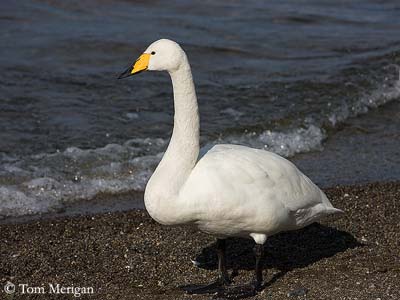
Whooper Swan
Cygnus cygnus
Anseriforme Order – Anatidae Family
BIOMETRICS:
Length : 146-165 cm
Weight : 7,5 – 12,5 kg
LONGEVITY: Up to 26 years
DESCRIPTION:
Whooper Swan is a large swan of the northern parts of Europe and Asia. It is closely related to the Trumpeter Swan (Cygnus buccinator) of North America which has black bill.

Adult has white plumage overall, with sometimes rufous wash on head and neck, due to some waters where it feeds.
The bill is pale yellow with black tip and cutting edges. Eyes are dark brown. Legs and webbed feet are black.
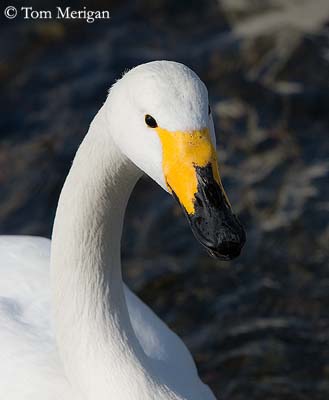
Both sexes are similar, with female slightly smaller than male.
Juvenile is greyish brown with darker head and neck, and whiter below.
It reaches the white adult plumage before the second winter.
The bill is pink with paler base and brown tip and cutting edges. Legs and feet are pinkish-grey. It reaches its sexual maturity at 4 years.
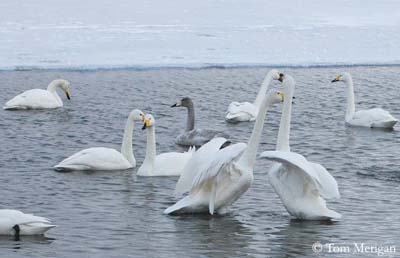
ADULTS
AND
JUVENILE
VOICE: SOUNDS BY XENO-CANTO
Whooper Swan gives several varied hoot-like calls. In flight, it utters typical loud and low “houp-houp”.
HABITAT:
Whooper Swan frequents wetlands, shallow waters such as lakes and pools where it breeds, often in wooded areas. It also may be found in sheltered coast flats and quiet rivers.
It winters in low farmlands, usually near the coasts.
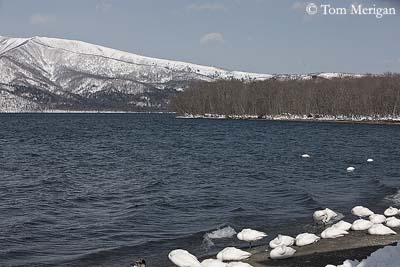
RANGE:
Whooper Swan breeds in taiga, in Iceland and Scandinavia, E to NE Siberia.
It winters in western and centre Europe, around the Baltic, and in North, Black, Caspian and Aral Seas, and eastwards to coastal China and Japan.
BEHAVIOUR:
Whooper Swan feeds mainly on aquatic plants and grass during the breeding season. In winter, it also consumes grains, acorns, potatoes and vegetable matter.
This swan forages on water, performing head-dipping or upending, but it also grazes on the ground.
On feeding areas, the Whooper Swans gather in large flocks of up to 300 birds, because they are very gregarious outside the breeding season.
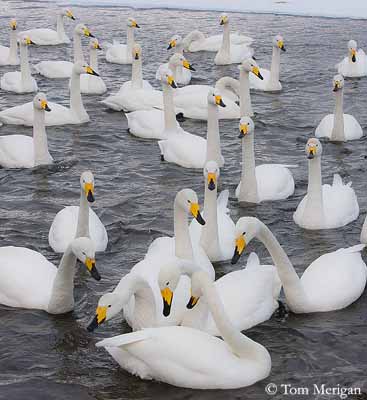
Whooper Swan is migratory, although some parts of the Iceland population remain in the breeding range. The others migrate southwards to more temperate areas.
Whooper Swan pairs for life. Mates perform courtship displays with male and female facing each other, with half-opened quivering wings in raised position. Each bird alternatively bends and extends the neck. These displays are accompanied by loud trumpeting calls.
Whooper Swan defends strongly its territory during the nesting period.
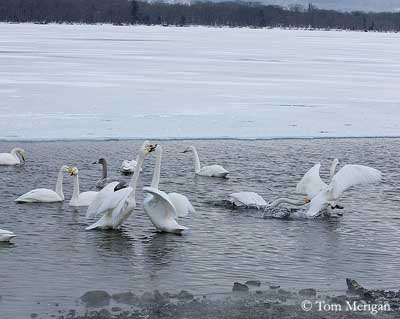
FLIGHT:
Whooper Swan is a good flier in spite of its large size.
Take off and landing may be something difficult, but it takes off by running on the surface, and lands with the feet hold forwards when touching the surface.
Wing beats are more silent than in Mute Swan (Cygnus olor). During the migrations, these swans fly in V formation at good height while they often utter contact calls.

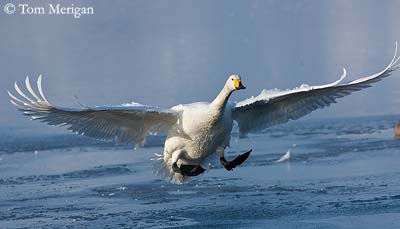
REPRODUCTION:
Breeding season starts in late April-early May.
Whooper Swan is solitary nester. The nest is situated on large mound made with plant matter, usually moss and lichens. The nest is near water, on lake shores or on islands.
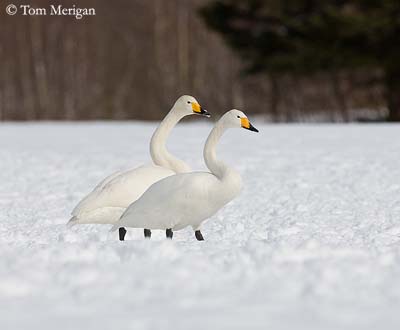
Female lays 4-5 eggs. Incubation lasts about 35 days, by female, while the male guards the nest-site.
At hatching, chicks are covered with pale grey down above, and white below.
They fledge at three months, and are able to fly at four-five months.
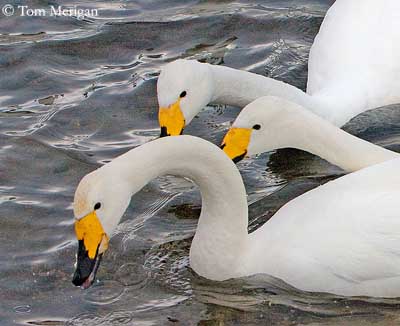
DIET:
Whooper Swan is mainly vegetarian, feeding on aquatic plants, grass, acorns, potatoes, grains and several kinds of plant matter.
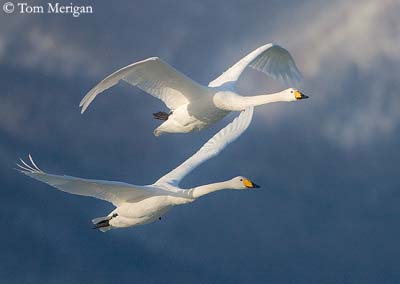
PROTECTION / THREATS / STATUS:
Whooper Swan is threatened by habitat loss, with drainage of wetlands, but also by hunting.
Populations seem to be fairly stable at this moment, but the wide range of this species makes difficult the estimations.
Fr: Cygne chanteur
All : Singschwan
Esp : Cisne Cantor
Ital: Cigno selvatico
Nd: Wilde Zwaan
Russe: Лебедь-кликун
Sd: Sångsvan
Photographs by Tom Merigan
His website:
Tom Meriganís Photo Galleries
Text by Nicole Bouglouan
Sources:
HANDBOOK OF THE BIRDS OF THE WORLD vol 1 by Josep del Hoyo-Andrew Elliot-Jordi Sargatal - Lynx Edicions - ISBN: 8487334105
GUIDE DES CANARDS, DES OIES ET DES CYGNES – de Steve Madge - Delachaux et Niestlé - ISBN: 2603013769
Birds of Britain - The Web Magazine for Birdwatchers
Wikipedia (Wikipedia, The Free Encyclopedia)